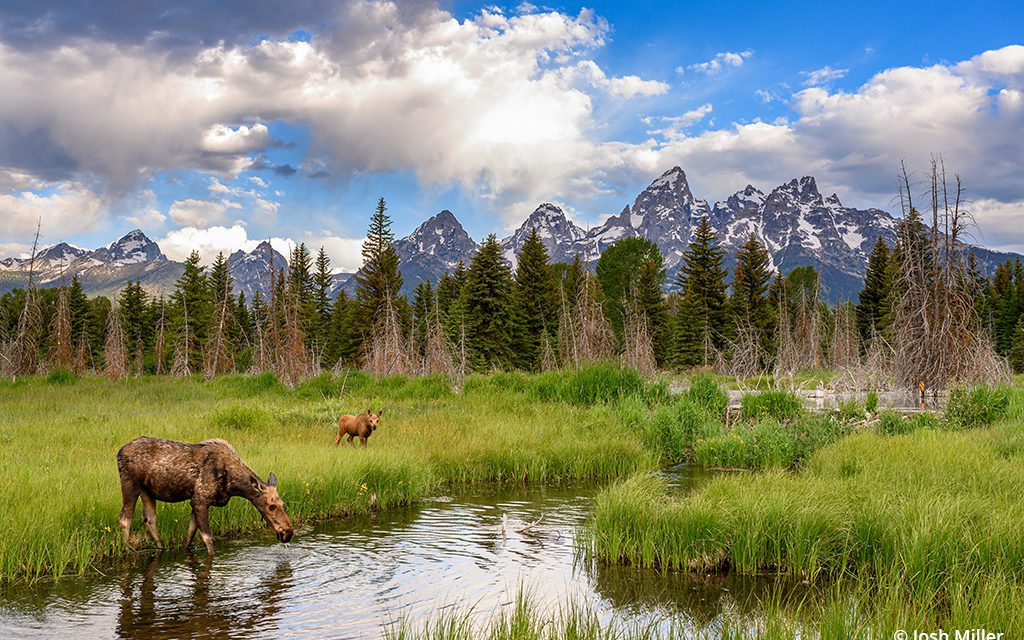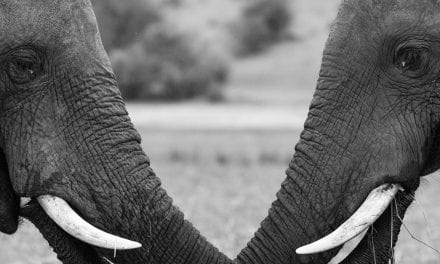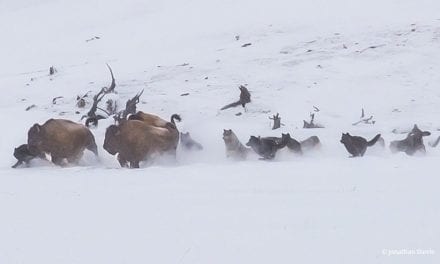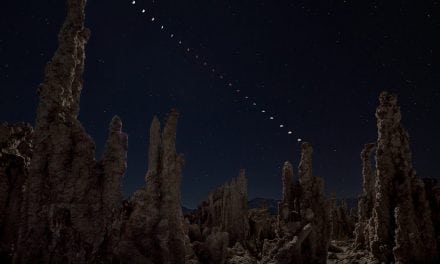When composing wildlife images, photographers usually concentrate on getting tight portraits using long telephoto lenses. That creative approach makes sense, as it brings the viewer closer to the subject. If we only reach for our telephoto lenses, though, we miss the chance to create dramatic wildlife-in-the-landscape images. Wide angle wildlife photos give more of a feeling of place, habitat and context, telling a bigger story about the subject than a telephoto shot can.
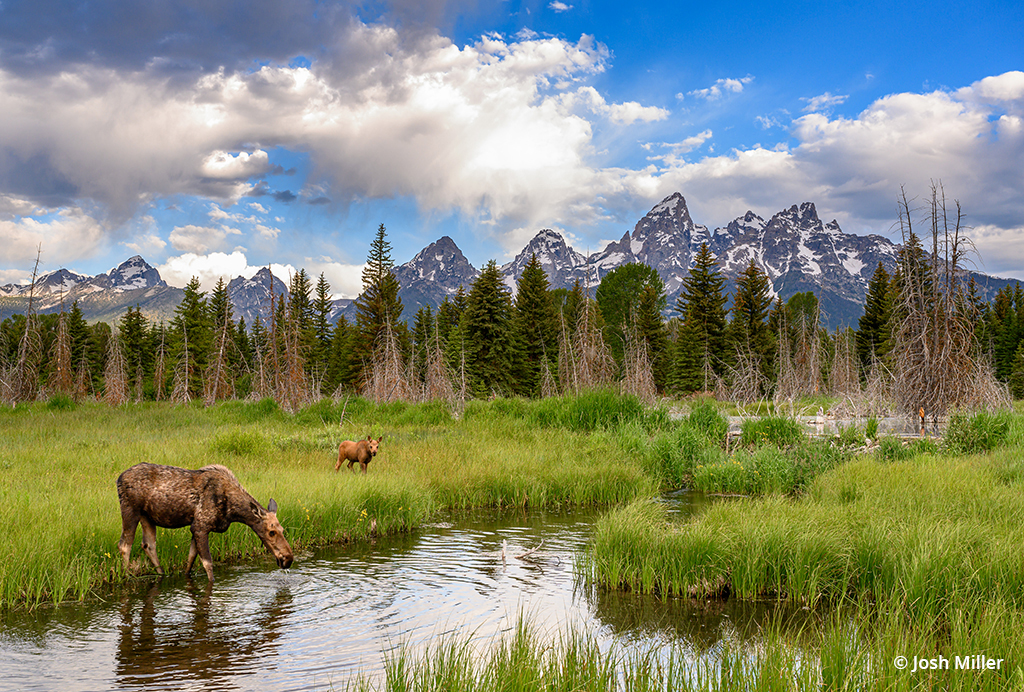
To me, this photo in Grand Teton National Park is all about the background. While I could have used a longer lens to get tight headshots of the cow and her calf, by shooting handheld with my 24-70mm, I was able to recompose quickly to include the background as the moose moved through the marsh.
I was reminded of this while shooting a moose and calf last summer in the Tetons. At first, I had the spot all to myself, but it wasn’t long before a few other photographers happened upon the scene. They all chose to shoot with a long lens to get tight shots of the moose. Meanwhile, I spent the entire two hours with the moose shooting handheld with my 24-70mm, realizing that it was the Tetons in the background that made the shot special, and I wanted to tell a story of the place. While I am sure the other photographers got great close-up moose images, I ended up with some of my favorite moose shots of all time.
Don’t get me wrong—I always have a big telephoto in my bag when there is potential for wildlife, but I’m also on the lookout for times when I can shoot wildlife with my wide angle. It’s true that most of the time, tight wildlife shots are going to be the most successful due to dim lighting conditions or the need to isolate your subject from a boring background. But every once in a while, when the situation presents itself with a great background and interesting lighting, I always choose the wider shot. In active wildlife locations, I have even gone to the point of staking out a great landscape scene and waiting for the wildlife to show up. While I may end up waiting for hours, the payoff is worth it when that mountain goat walks into your well-composed scene.
Wide Angle Wildlife: A Place To Live
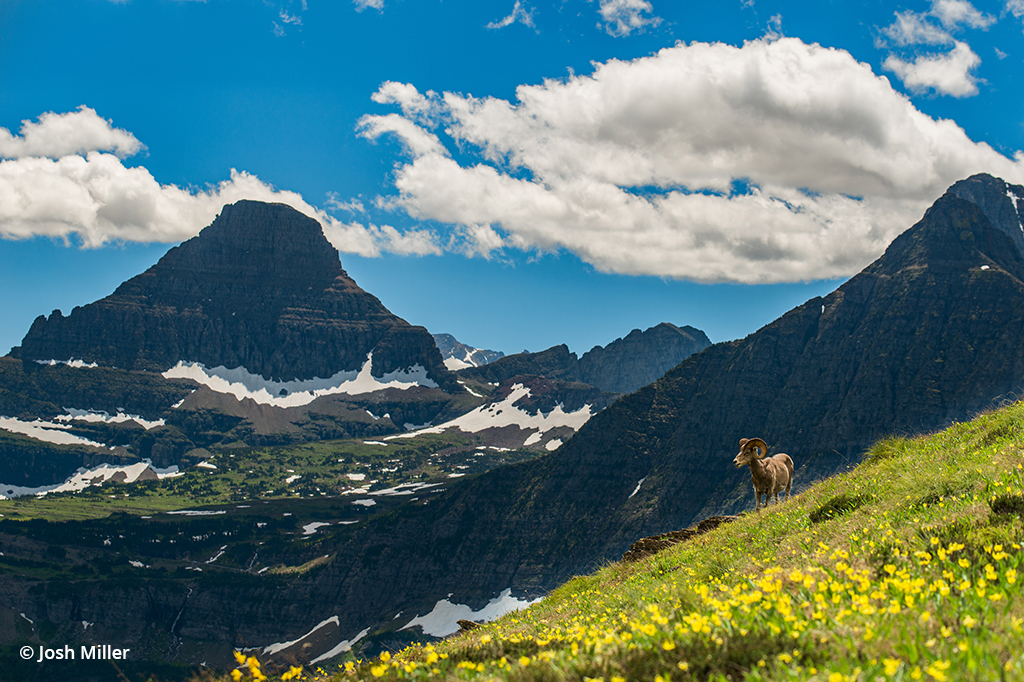
This image was made during a nearly 20-mile day hike through the Glacier National Park high country. While I love how the bighorn sheep gives a feeling of scale to the larger dramatic landscape, the truth is that because I was doing such a long hike, I hadn’t carried a lens longer than 120mm. If I had a longer lens, I likely would have missed this shot. Sometimes limiting the focal lengths you have with you forces you to be more creative.
Call it artistic style, but personally, I have always been more drawn to images that give the subject a place to “live.” We have all seen those amazing tight shots of an animal running or a bird in flight, but without some feeling of the landscape, I find it hard to connect with these images. This has even transferred into some of the adventure photography work I do, where I typically render my subject athletes (runners, bikers, skiers, etc.) a small part of a larger scene. Giving the subject space in an expansive scene creates a feeling of scale and drama.
Perhaps it comes from the fact that I was primarily a landscape photographer for a long time, and thus I tend to build my wildlife images the same way. First, I look at the light to see if anything dramatic is happening. Then, I start looking for strong leading lines or strong foregrounds and backgrounds that create a feeling of depth. Then, and only then, do I start trying to add in the wildlife.
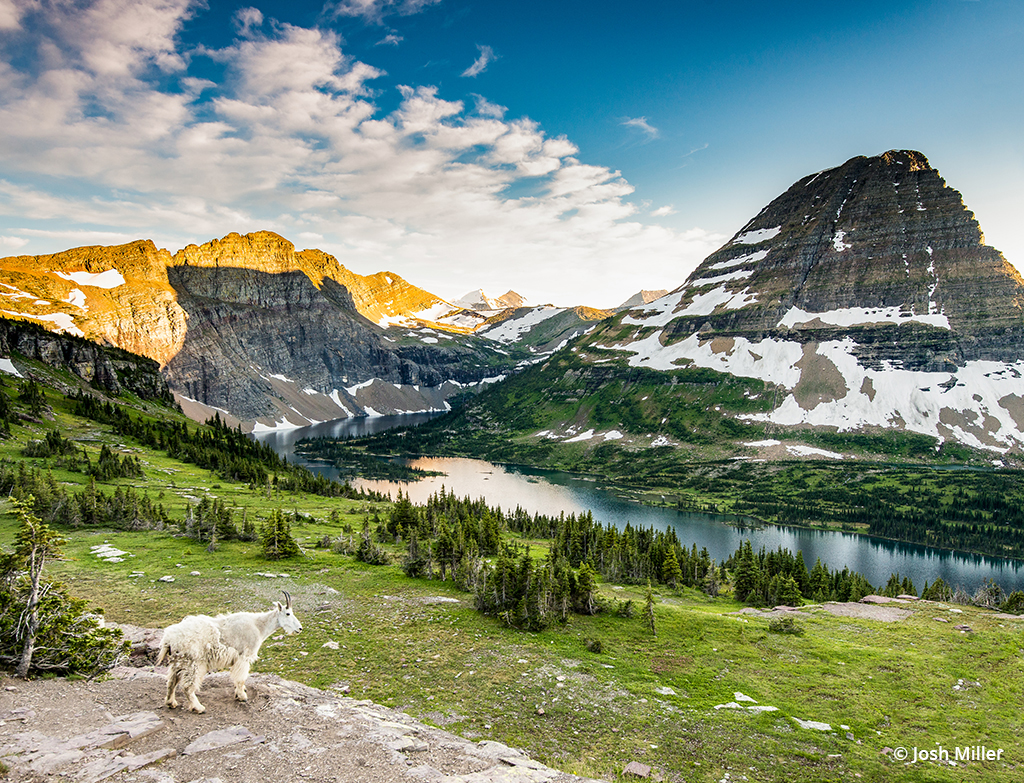
This is one of my favorite locations in Glacier National Park. Not only does it have an amazing view late in the day, but it is also a good spot to find mountain goats. In this case, I was there with a group of non-photographer friends who continued their hike farther, but I chose to find a composition and wait until one of the goats entered my pre-composed scene.
I think part of the reason we see fewer strong wide angle wildlife photos is because shooting wide is far more difficult than shooting tight when you have no control over your subject. When shooting tight, you have the ability to remove distracting elements from the background and focus exclusively on the animal. And yes, while it is far easier for me to create dramatic wide shots of an athlete running through a well-constructed scene when I can ask them to do it multiple times, there sure is something magical about that moose in a pond with a great background when it all comes together.
Thinking back to that moose, in two hours of shooting, I got probably fewer than 10 images that worked out with composition, body position, light, clouds…and of those, really just a couple are true “keepers.” Meanwhile, the long lens shooters probably went home with many successful shots. It was a sacrifice I was willing to make for the chance at something truly special.
One other advantage I may have had that made skipping the tight shot easier was also knowing I already have good close-up moose shots in my files at home. As they say, the more shooting you do, the more good shots you make—and perhaps the easier it is to take risks.
Improving Your Chances For Successful Shots
The first step to improving your chances of success with wide angle wildlife photography is being familiar with the landscape and knowing where and when wildlife will be there. Often this is directly connected to a good natural history understanding of your chosen species and its food sources.
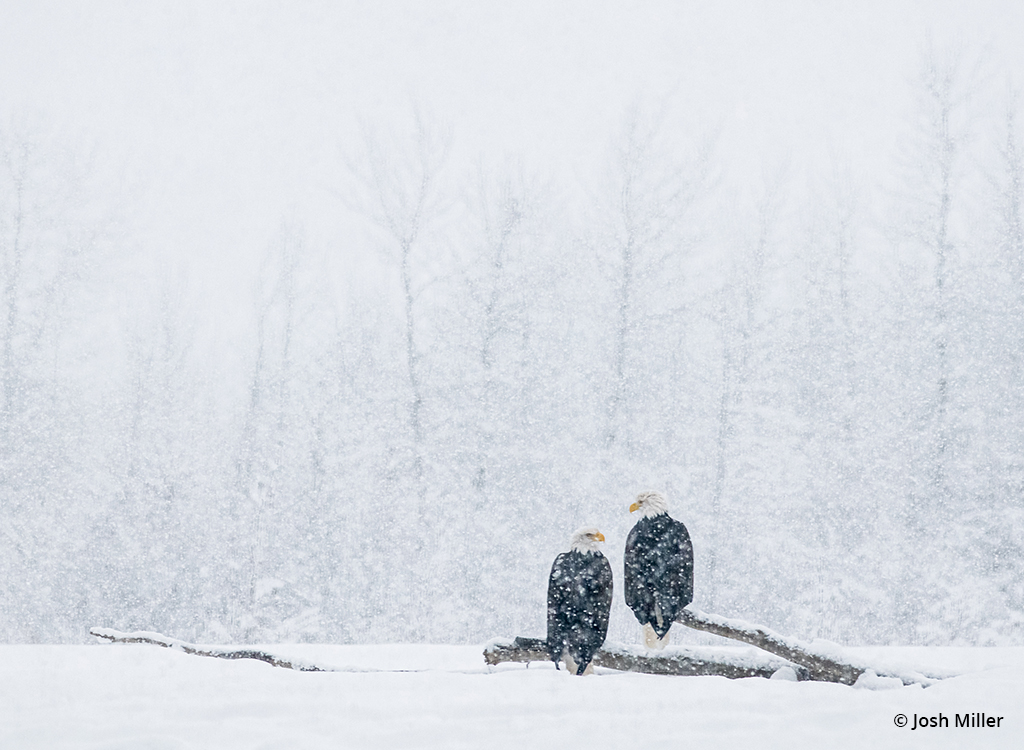
I made this image during one of my Alaska Eagle workshops. We were all shooting this eagle pair with our long lenses, but by shooting tight, we were losing some of the drama of the background. By switching from my 500mm lens to something shorter, I was able to make the eagles a part of a larger scene that included more of the background as well as more of the falling snow. While I have the tighter shots in my files as well, it is this wider version that has become one of my favorite eagle images of all time.
When I lead bald eagle workshops in Alaska, we time them to coincide with the last salmon run of the year, so we know the birds will be there and be hungry. When we find a salmon pulled up on the bank or stuck in the shallows, we plan our compositions accordingly by first looking at possible backgrounds and then finding a spot to wait for the eagles to come and play their part as actors on our chosen stage—usually within just a few minutes.
The same principle applies for other subjects as well. Look for food sources, game trails or water sources, stake out a good composition and then wait for the action. The fact is that most of us spend too much of our wildlife shooting moving around and not waiting for the action. Think of a trip to a place like Yellowstone. Most photographers I see tend to drive around looking for wildlife and only stop to shoot if wildlife is close to the road. (I may be guilty of this at times as well.) While this may work alright with large grazing animals like bison, rarely do photographers who are always on the move get well-composed wide angle wildlife shots with great light of more wary, reclusive subjects.
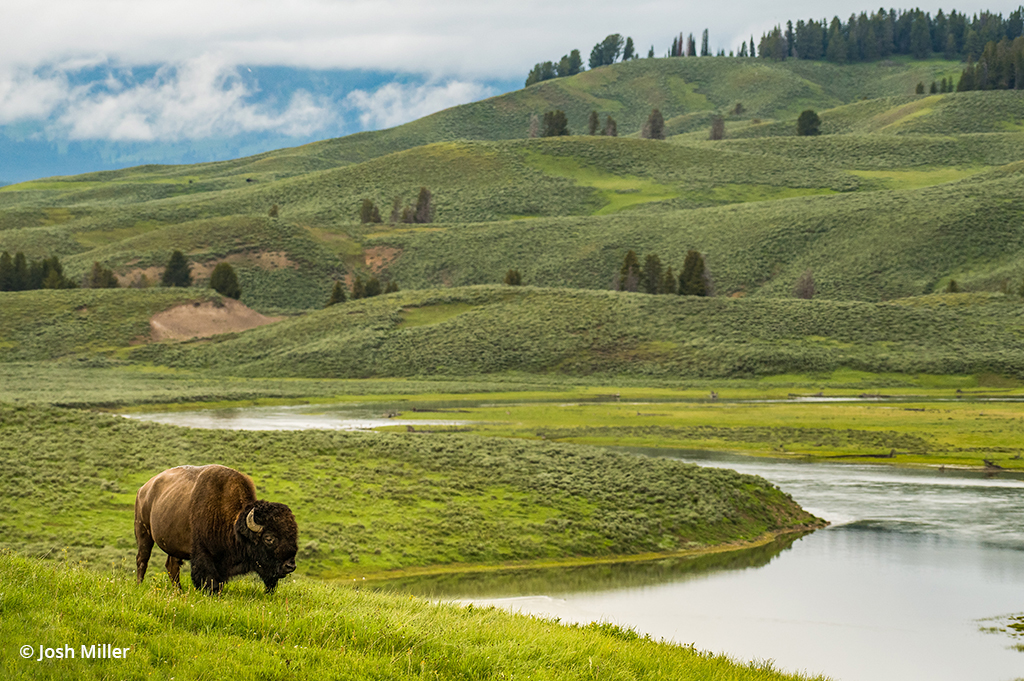
We all see lots of tight shots of the bison in Yellowstone, but to me, this shot is all about the dramatic landscape of the Hayden Valley with a bison to give it scale. I had been exploring and shooting along the road all morning as a rainstorm moved through the park, but when I saw this lone bison walking toward this scene, I pulled over and waited for him. Sitting on a hillside in the rain with my 200-500mm handheld, I was able to shoot several different compositions at different focal lengths as he walked through the field.
Sometimes the best thing we can do is sit down with pair of binoculars and wait. One of my more productive shooting sessions in Yellowstone was when we spent most of an entire day photographing a bison kill. The wolves we had hoped to shoot never did show up, but we had quite a show from the coyotes as they fought over the dead bison. And with time on our hands, we were able to focus on wider compositions in addition to the classic tight shots. While not a true “wide-angle” shot, my favorite image ended up being of a coyote laying down as a small part of a wintery scene.
Lastly, speaking of binoculars: If you are serious about wildlife photography, you need good pair of binoculars. We spend thousands of dollars on cameras and lenses, and it’s amazing what even a $300 pair of binoculars will do for spotting and following wildlife. Someday, I would love to have a nice pair of Swarovski binoculars, but my old, beat-up Nikon Monarchs are still about the best value on the market and are with me every day, whether I am guiding or just shooting for myself.
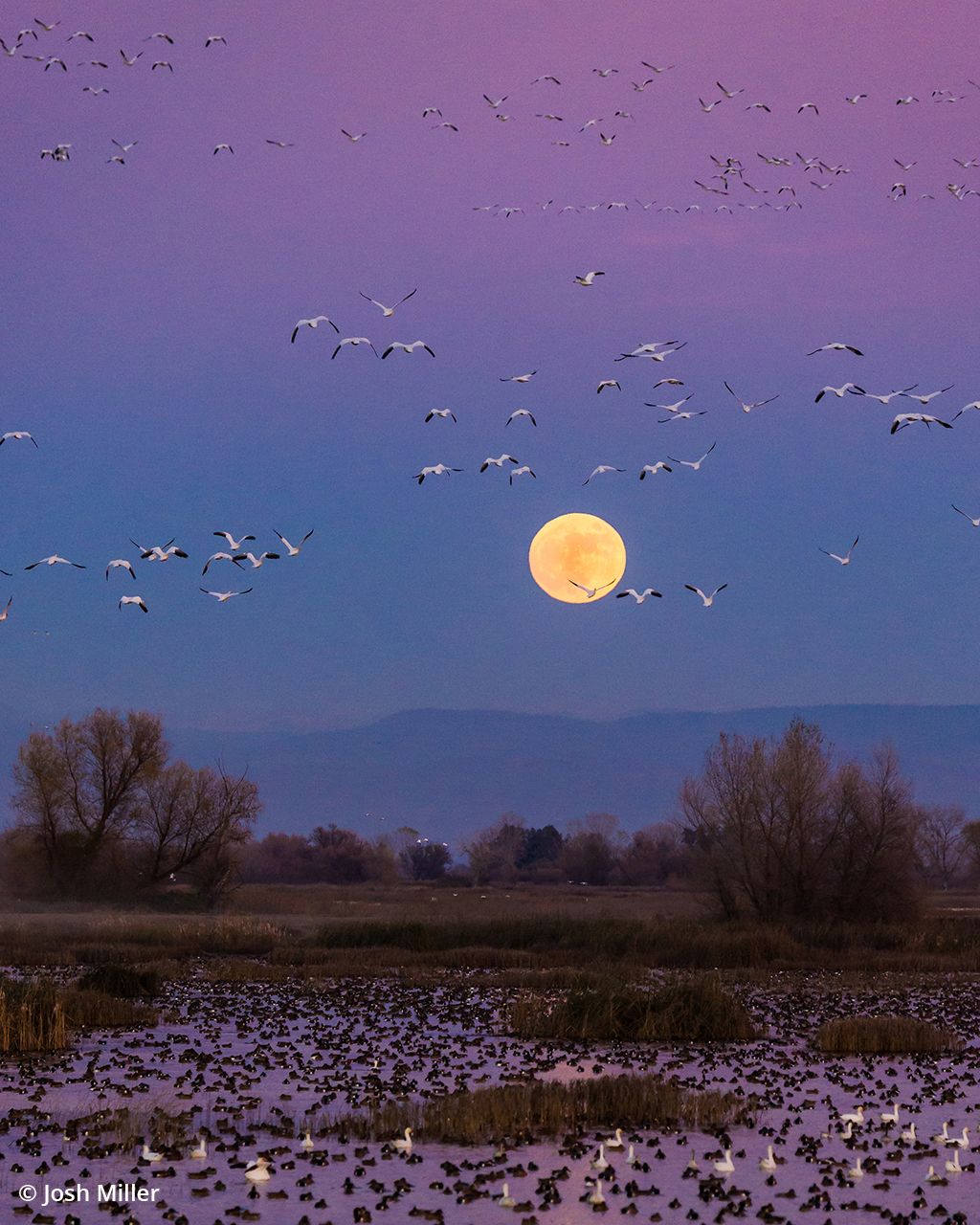
This photo was made at the end of a great day of birding with friends at Grey Lodge Wildlife Refuge in the central valley of California. Being with a group of non-photographers, I had safely stashed my camera away in the trunk, waiting for just the right moment. Knowing the full moon would be rising at sunset, we drove to the far end of the auto loop, where I could be farther away from the landscape, allowing me to make a “wider” shot using a longer focal length to bring the moon in close and make it look larger.
The post Wide Angle Wildlife appeared first on Outdoor Photographer.

